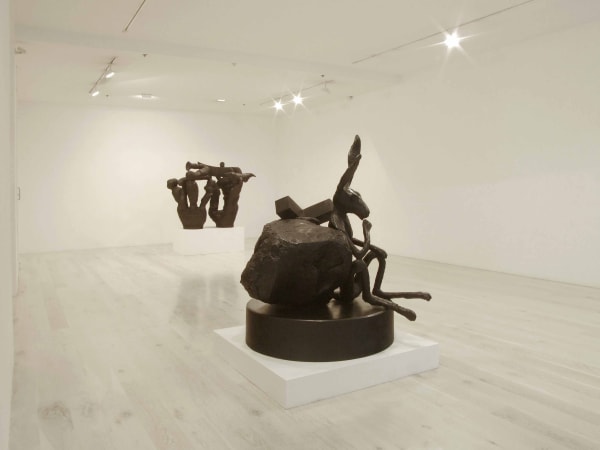Heavyweights: Sculpture from the UK
The future of sculpture has only just begun. Its potential is greater now than ever before and its possibilities are just starting. Its language and its forms are just beginning to evolve...
The future of sculpture has only just begun. Its potential is greater now than ever before and its possibilities are just starting. Its language and its forms are just beginning to evolve...
Tony Cragg interview with Jon Wood from In and Out of Material, Germany, Verland der Buchhandlung, 2006, p.13
Celebrated British sculptors, Barry Flanagan (b.1941, Wales) and Tony Cragg (b.1949, Liverpool) feature in Gow Langsford Gallery's upcoming exhibition, Heavyweights - Sculpture from the UK. As two of the most important representatives of Contemporary British Art to emerge of their generation, remarkably, it is the first time that Flanagan's work has been exhibited in a New Zealand dealer gallery and only the second time for Tony Cragg, whose impressive sculpture Clear Glass Stack (1999) was purchased by the Auckland City Art Gallery Toi o Tamaki during his inaugural show at Gow Langsford Gallery in 2005.
The title of this show is derived from the idea that 'weight' is a fundamental consideration in sculpture - not least of all for Cragg and Flanagan who are regarded as 'heavyweights' in their own right among the art world. While each artist pursues quite different objectives and with equally diverse methodologies, as sculptors they must ultimately reconcile complex formal issues that are associated with pure physics that include weight and extend to gravity, mass, form, and space.
Former Turner Prize winner, Tony Cragg is a pure technician whose inquiry into the possibilities of sculpture is arguably, unsurpassed. His work is distinguished by an experimental approach, agility with materials, and reinvention of form. These proficiencies are evident throughout his work; from his early found industrial products, to his arranged fragments and remnants; to scientific models and his vessel forms. Cragg's experience working as a laboratory assistant after leaving school has influenced and served his work throughout his career, bringing him the ability to combine powers of observation and philosophical ideas.
Barry Flanagan works primarily as a figurative sculptor and is largely renowned for the use his archetypal motif, the hare. Thinker at Rock Cross (1997) exemplifies Flanagan's signature style, where monumental bronzes feature anthropomorphic hares engaged in a variety of playful and spirited activities such as dancing, making music, playing sports and in this case, contemplating. Flanagan's unique body of work captures the sense of spontaneity and vivacity associated with the hare and in doing so challenges conventional notions of heroic sculpture through wit, humour, subject matter and scale. While Cragg pushes the boundaries of physics, Barry Flanagan is concerned with the unconventional non-science of 'pataphysics'- a fascination he shared with Pablo Picasso. A conceptual principle which engendered the Dadaist and Surrealist movement, pataphysics parodied the theory and methods of modern science and was characterised by the illogical and nonsensical. This liberation from rationalism allowed small to become large, heavy to appear light and the incongruous to become the norm. Thinker at Rock Cross therefore, may be read as an irreverent and witty response to Rodin's The Thinker (1880).
Tony Cragg and Barry Flanagan are both veterans in the international art arena and were elected as members of the distinguished Royal Academy during the early nineties. Cragg has been exhibiting extensively internationally since the early 1980's, and in 1988 was awarded the Turner Prize for his exhibition as the British representative at the Venice Biennale. In 2003 Cragg's significance was affirmed by a major retrospective, Tony Cragg: Signs of Life, at the Kunst und Usstellungshalle der BDR, Bonn, Germany, this exhibition was accompanied by a major catalogue publication surveying his work over the past thirty years. Flanagan has also exhibited extensively in major galleries worldwide including the Royal Academy of Arts in London, the Centre Georges Pompidou in Paris and MOMA in New York. His work is held in numerous major collections including MOMA in New York, the Tate Gallery in London, the National Gallery of Canada, the National Gallery of Art in Washington DC, the Musee des Beaux-Arts and the Victoria & Albert Museum in London.





